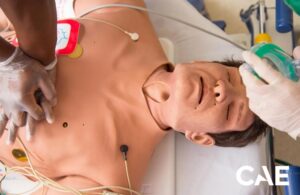Human Patient Simulator
One of the newest teaching modalities in health education is the use of human patient simulators (HPS) for healthcare simulation. A Human Patient Simulator is a life-like manikin designed to react physiologically, as if the product were a real-life patient. This is possible because ever-advancing technology has made the production of computer software that can be integrated into the manikins possible. Other names for these devices include high fidelity patient simulators, patient simulators, mannequins, medical simulators, nursing simulators, ob simulators, surgical simulators, pediatric simulators and more.
This type of computer software allows Human Patient Simulators to replicate normal and abnormal bodily responses for educational and training purposes. Often these responses are initiated by a number of physical events taking place, such as an asthma attack. Therapeutic interventions can also be replicated under certain circumstances, including that representing a side effect of a medication.
The organs of one of these lifelike medical simulators, including their heart, blood vessels, lungs and gastrointestinal tract, can also be made to respond to a variety of human interventions during clinical simulation engagements. Another way in which Human Patient Simulators are able to represent the human body is in the case of a defibrillator, which can deliver a live shock to the body. Moulage is usually added to the patient simulator, to best present the patient’s vital signs and symptoms to learners.
Sponsored Content:
Proving effective in training as well, intravenous needle can be used to penetrate the simulator’s skin. Simulated blood can additionally be pumped into the simulator’s veins through an IV tube. Together, all of these applications are able to provide first-hand instruction, without the risk associated with practice on actual patients — driving improved learning opportunities especially in nursing simulation.
In short, Human Patient Simulators are the next best thing to a human patient — without a real person’s vulnerability. Their accessibility and ease in use have provided learners with educational opportunities increasing both their skills and confidence.
High-Fidelity Manikin-Based Human Patient Simulators
One type of Human Patient Simulators are the high-fidelity and manikin-based ones. Often, these medical simulators are said to look and behave more like humans than any other medical simulation equipment, according to Samuel Merritt University.
Sponsored Content:
The university explains that these high-fidelity manikin-based simulators give learners the opportunity to “immerse themselves in a simulated clinical scenario that looks and feels real.” The combination of the simulator and the environment utilized by the university’s Health Sciences Simulation Center team allows the learners to suspend disbelief and to care for the simulator as if it were a real patient, and not just a manikin.
The University of North Carolina has also commented on the importance of Human Patient Simulator incorporation as an educational tool. On the university’s website, leaders share that. “The University of North Carolina’s Department of Anesthesiology aggressively explores new learning techniques. We are committed to providing our residents with state-of-the-art educational tools. In keeping with commitment we have both pediatric and adult Human Patient Simulators for medical student and resident education and for research.”
One of these educational and research tools, the Adult SimMan, is a high-fidelity manikin product that registers most of the vital signs used in emergency medicine. Created by Laerdal Medical, each full-body Adult SimMan 3G comes with a patient monitor that displays X-rays and 12-lead echocardiograms.
During a scenario the manikin’s anatomy can be modified (from the control room) to show changes in the patient’s condition or responses to an intervention. This is shown so that learners can reach a diagnosis from observation, rather than from instructor cues.
Then, representing the body of an infant, the Laerdal SimBaby manikin allow learners to practice and demonstrate their ability to treat an infant or toddler. SimBaby responds physiologically through computer software to the care being given.
A realistic airway allows for SimBaby training in all aspects of infant airway management. The manikin’s anatomy can be dramatically changed to represent adverse conditions, such as tongue edema, pharyngeal swelling or laryngospasm. SimBaby also comes with an IV arm and IV/IO legs for practicing peripheral intravenous and intraosseous therapy.
As newborn care can differ from general infant care, Laerdal further created the SimNewB. This is an interactive simulator created in collaboration with the American Academy of Pediatrics to meet the training requirements of the Neonatal Resuscitation Program (NRP).
SimNewB accurately represents a full-term, 50th percentile newborn female measuring 21 inches and weighing 7 pounds. A wide variety of patient conditions can be simulated, ranging from cyanotic newborn with no vital signs to a moving, crying, vigorous newborn.
Focused on newborn care as well, the Gaumard products, the Noelle Maternity Simulator and Noelle’s Newborn Baby Hal, are high-fIdelity manikin-based Human Patient Simulators that represent a birthing mother and child. The Noelle Maternity Simulator is a wireless birthing manikin designed to exhibit the entire birthing experience. Then, Noelle’s Newborn Baby Hal demonstrates a wireless neonatal manikin that can be used independently or in conjunction with the Noelle birthing simulator.
CAE Healthcare also has a range of advanced patient simulators ranging from pediatric simulators to OB maternal simulators and surgery simulators. The Society for Simulation in Healthcare’s annual conference IMSH is a great place to see all of the latest medical simulation products.
Mid-Level Fidelity Human Patient Simulators
Mid-level fidelity simulators are designed to perform many of the same functions as their high-fidelity counterparts, but are simpler and therefore require less training to operate. Being less complex, these manikins often come at a lesser price.
One type of mid-level fidelity Human Patient Simulator is the VitalSim, including Anne, Kelly and Kid. These Laerdal manikins, which simulate ECGs, heart sounds, breath sounds, bowel sounds, blood pressure and pulse. Beginners and advanced learners alike are able to improve their skills with health assessments using these easy-to-use manikins, and faculty have quickly learned to integrate them into the curriculum.
Another version with mid-level fidelity, MegaCode Kelly and Kid are also Laerdal manikins utilized by learners to prepare for pre-hospital emergencies by practicing such life-saving skills as intubation, chest tube insertion and defibrillation. Note: Sam-I-Am, the MegaCode Kid, is the pediatric version of the Kelly manikin.
Created at the Center for Research in Medical Education at the University of Miami for even more in-depth practice for learners, the life-size Harvey cardio-pulmonary simulator will exhibits all the physical signs of cardiac disease. This manikin is additionally programmed with 30 cardiac conditions and more than 200 different bedside findings.
Rounding out mid-level fidelity Human Patient Simulators available on the market, the Pelvic ExamSim, created by METI, allows learners to practice sensitive female pelvic examinations. Touch-Sensitive technology provides objective and measurable feedback to learners and instructors alike.
Overall, research is showing that these devices are expanding their use across educational and training platforms, while becoming more widely adopted by universities, colleges and secondary education facilities across the world.
Patient Simulator Latest News

Leading Clinical Simulation Products from Nasco Healthcare

TacMed Solutions Launches Female Trauma Patient Simulator MATTi

Defense Health Agency’s MST PMO Works to Optimize Warfighter Readiness and Improve Healthcare with Simulation

Wearable Device Technology for Enhancing Clinical Simulation

Lifecast Body Simulation and Echo Healthcare Release World’s First Child Manikin with Down Syndrome

How to Run a Postpartum Hemorrhage Nursing Simulation Scenario

The SAFETY Project: Healthcare Simulation Approach to Medical Education

Assistant Dean of Medical Education Shares Benefits of PCS Spark in Clinical Setting

CAE Healthcare Basic Lifesaving Manikin Supports Valuable Training

CAE Healthcare Patient Simulators Improve Nursing Preparedness
Sponsored Content:
















